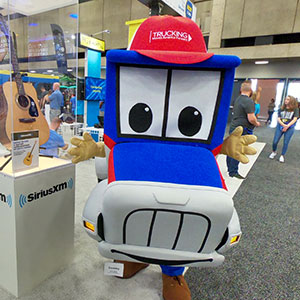Forbes: How Big Data Is Changing Long-Haul Trucking
By Erin Richey
On a long stretch of highway, a semi-trailer sends a message to a trucking company that the truck’s refrigeration unit is warming up. Before the temperature in the trailer has a chance to affect the product being transported, the company notifies the truck driver of where to get it fixed, keeping the truck’s contents from being ruined.
Back at company headquarters, trucking experts connect with drivers on the road who are trying to improve fuel economy. In a series of phone conversations, they work together to diagnose equipment problems or improve driving habits, allowing drivers to make fewer fuel stops.
These are just two examples of how big data and trucking have intersected for early adopters like C.R. England Inc., one of the largest for-hire motor carriers in the country.
Telematics and electronic on-board recorders (EOBRs) are revolutionizing how large motor carriers transport goods, using intelligent systems that collect data and communicate in real-time to ensure that groceries arrive unspoiled, drivers are less fatigued and highways are safer for everyone. Big data has brought the potential to preserve, and possibly expand, the trucking industry’s narrow profit margins, and experts believe it won’t be long before multi-purpose monitoring units are installed in every semi-trailer in America.
Toward “total cost of ownership”
C.R. England has installed in-cab telematics systems in every one of its company and independent contractor vehicles: that’s 4,500 revenue-producing trucks, plus training and auxiliary vehicles. The devices track driving hours, fuel efficiency factors, location and critical events like hard braking and the activation of trailers’ roll stability controls. All of that is communicated in real time to the company, by satellite or cell tower, and used to make decisions en route.
“If you’re adopting EOBR and not using that now-visible log data in your planning and swap decision making, then you’re not taking the most advantage of that data,” says Ron Hall, senior director of operations technology at C.R. England. In 2008, the company began implementing EOBR at the encouragement of Chad England, the current CEO, who was the senior executive for safety and recruiting at the time.
Since then, the data collected by EOBR and telematics units in the fleet have been used to make major purchase decisions. “When we award business to a particular tractor manufacturer—and we review this yearly—we will actually award the business based on total cost of ownership, not just the purchase price, and fuel consumption is a major factor in that total cost of ownership model that we make our decisions off of,” says Hall.
The number crunching has paid off. According to Hall, the devices have helped the company reduce deadheading (trailers traveling empty between unloading and reloading) from 8 percent of miles traveled to below 7 percent, and he estimates fuel efficiency improvements at a tenth of a mile per gallon per year for the last three years.
Although big trucking companies have eagerly adopted big data strategies in their business models, smaller carriers have been less enthusiastic.
“The small guys, based on our research, typically delay a major technology investment three to five years,” says Dan Murray, vice president of research for the non-profit American Transportation Research Institute. He adds that after bigger carriers have outfitted their fleets and tested early versions of products, prices usually drop and models are usually easier to implement, given input from early adopters.
“The question is, can the small guys survive long enough to benefit from the technology? The trucking industry’s average profit margin is about 3.6 cents on the dollar,” says Murray. “So we only invest in technology that has an almost immediate ROI, and it has to have a pretty fast payback or break-even point, within 12 to 18 months.”
Lying on log books
The Federal Motor Carrier Safety Administration will soon require all carriers to install some type of electronic on-board monitoring device in vehicles to track vehicle status and how many hours a driver has been on the road. Proponents of the new rules, such as president of the Arkansas Trucking Association Lane Kidd, say that electronic devices will improve trucking safety.
“Three million truck drivers today still use a paper log book, which is the same system we’ve had in the industry since 1938. And the worst kept secret is that drivers lie on their log books,” says Kidd. He believes that EOBR will, first and foremost, improve highway safety by preventing driver fatigue. “It gives the company a better view of what’s actually happening out on the highway.”
C.R. England compliance manager Kevin Carlisle says that for as many carriers that have implemented EOBR systems, “there are many, many more companies that are not using electronic logs.” And they’re missing out on a key advantage of adopting electronic logs: Carlisle says annual inspections found errors in 55 to 67 percent of paper logs, which can result in fines or detention of trailers. With the new electronic logs, he says, inspectors sometimes find no errors in their drivers’ logs during an inspection period.
The future of telematics and big data in trucking, says Murray, lies in cross-referencing real-time driver data with data on weather, parking availability and traffic delays to deliver information to the driver as quickly as possible. For instance, a driver’s device might tell him or her if weather ahead will cause a delivery delay that would extend past the maximum driving hours for the trip and then direct the driver to the nearest available parking area.
“I would say that within a couple years that level of sophistication will be out in the truck—for sure within two to three years,” Murray says.


